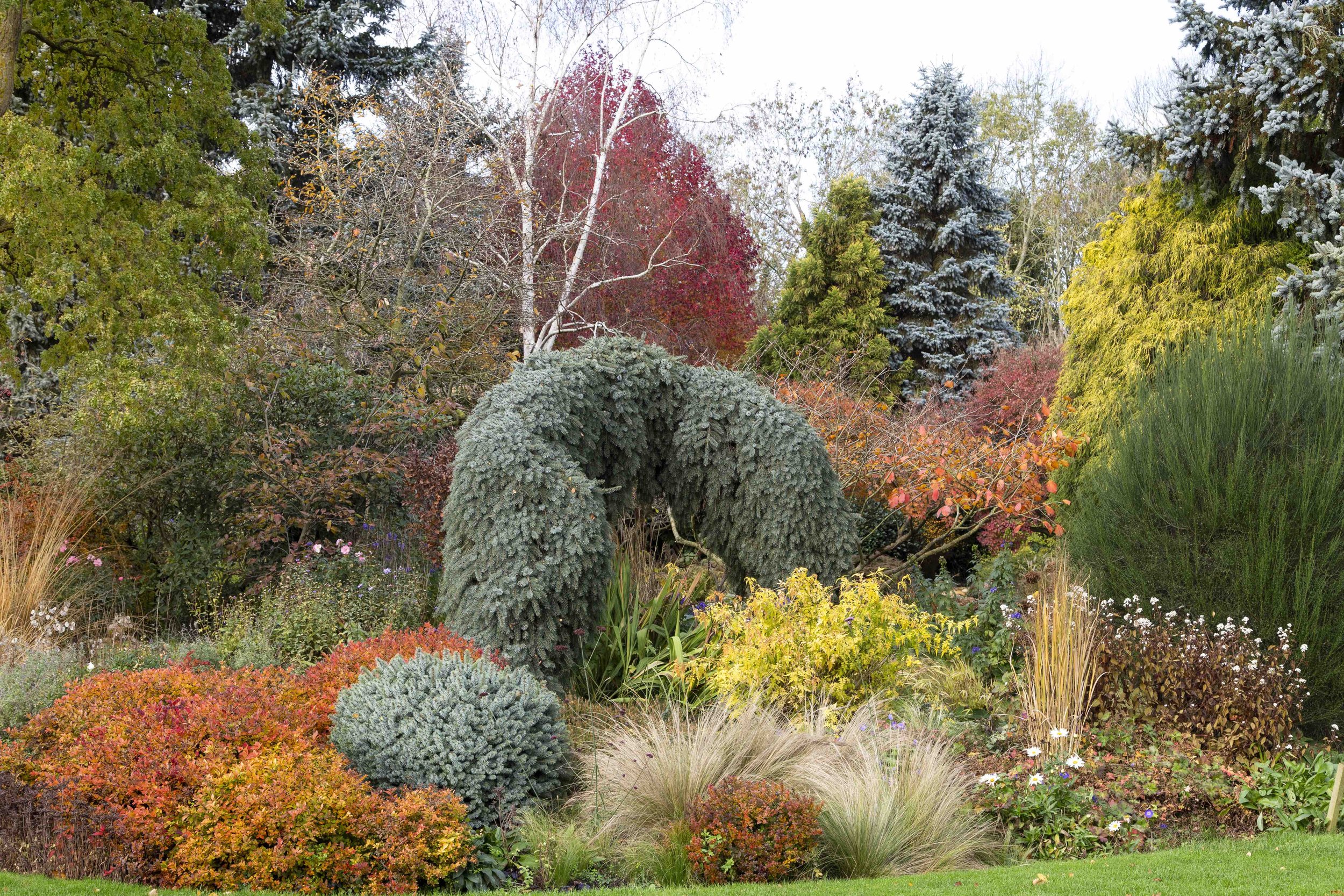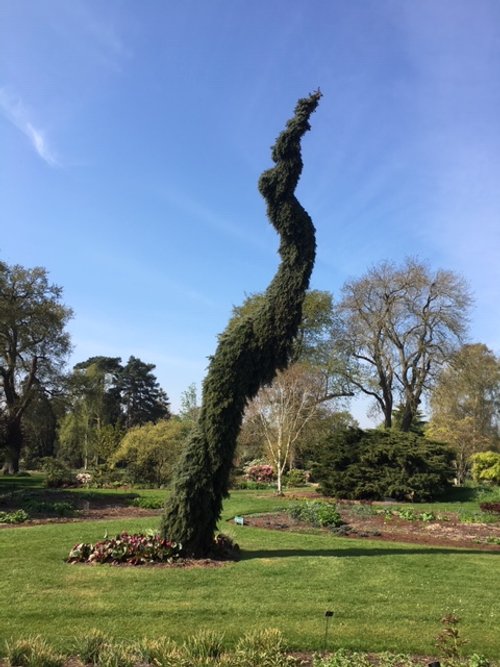Picea omorika Pendula Bruns
A fascinating story
This article by Adrian Bloom appeared in RHS Plant Review
Picea omorika Pendula Bruns , has the common name of “ Bruns Weeping Serbian Spruce “ , a striking selection which arose as a seedling on the Heinrich Bruns nursery in Germany.
As with so many plants that we observe and grow in our gardens, plants which can fit almost any description, fill various roles and have a name , botanical or descriptive... they all had to start somewhere , be discovered, selected or bred by someone. Perhaps the more substantial or long lived the plant , the more interest there might be in it’s name and origins, but the history can be an absorbing one. Seldom of course is there sufficient space in catalogues , magazines or even books to devote to a full in depth story which brings in the full history of a plant. But Picea omorika Pendula Bruns was not only an appropriate tree for remembering my brother as stands alone as an interesting and versatile conifer ( See Picea omorika Pendula Bruns as a garden plant ), so here is the low down on a plant we have grown in the gardens at Bressingham for 25 years. The origins of Picea omorika Pendula Bruns take us to back to the origin of the species ( thank Charles Darwin for that apt phrase), Picea omorika , The Serbian Spruce, a native of he Balkan Peninsula. Now where are the Balkans ? Perhaps like the Caucasus , they are to many of us places we haven’t yet visited ...
Although located in the heart of eastern Europe , Picea omorika was first ‘discovered ’near the small village of Zaovine on Tara mountain by Professor Josif Pancic in 1877 . The Professor, who had been aware of the species but not visited this exact location was a Serbian doctor, botanist and the first president of the Serbian Academy of Arts and Sciences.
Some of the first seeds collected from this inhospitable area were sent to the Froebel Nursery in Zurich , Switzerland 1881 who introduced the initial plants of the Serbian Spruce and within a few years it had become a ‘new ‘ sought after conifer recognised for it’s attractive habit and foliage, as well as adaptable to most soils and climates in Europe plant for garden, landscape and forestry. The Royal Botanic Garden at Kew was sent seed from Belgrade in 1889 and nearly a hundred years later in 1980 the tallest tree was measured at a height of 67 feet. Kew is on the drier side of Britain , and showing how well Picea omorika responded to a moister climate and perhaps more suitable soil conditions, a young tree planted at Murthly Castle in Perthshire , Scotland 1897 had reached 100 feet by 1988.
One reason that this spruce hadn’t been identified earlier was that it’s distribution was limited to a relatively small , remote and sparsely populated area , it’s natural range restricted to the upper ( 300 - 1700 m. ) slopes of Tara and Javor mountains of western Serbia following the upper valley of the river Drina. Interestingly Picea omorika had been widespread across Europe before the Ice Ages, but it is now it is only found growing in this very limited area close to and amongst the more common Picea abies, Norway Spruce , which has taken over the role as the most widespread spruce in Europe.
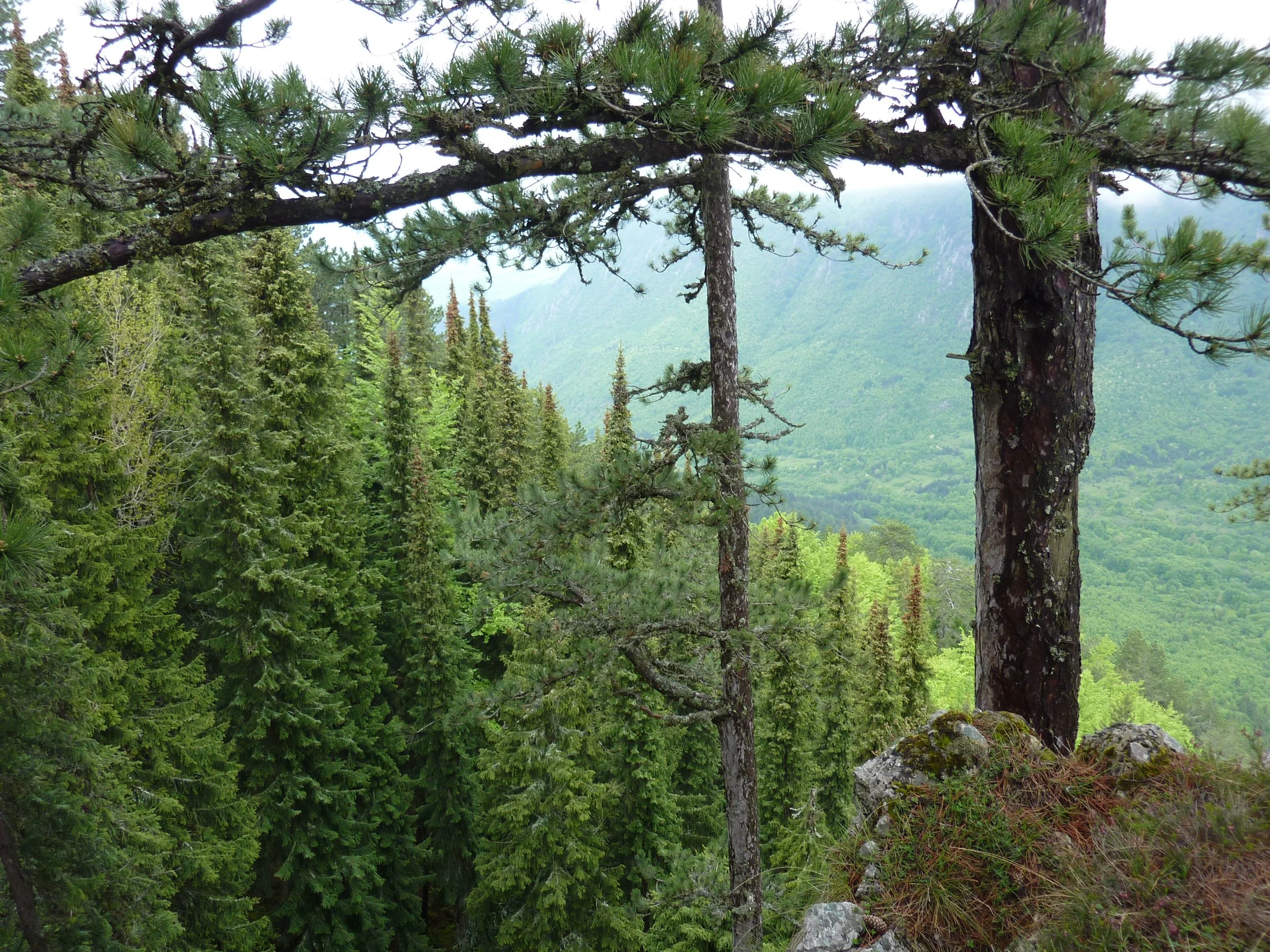



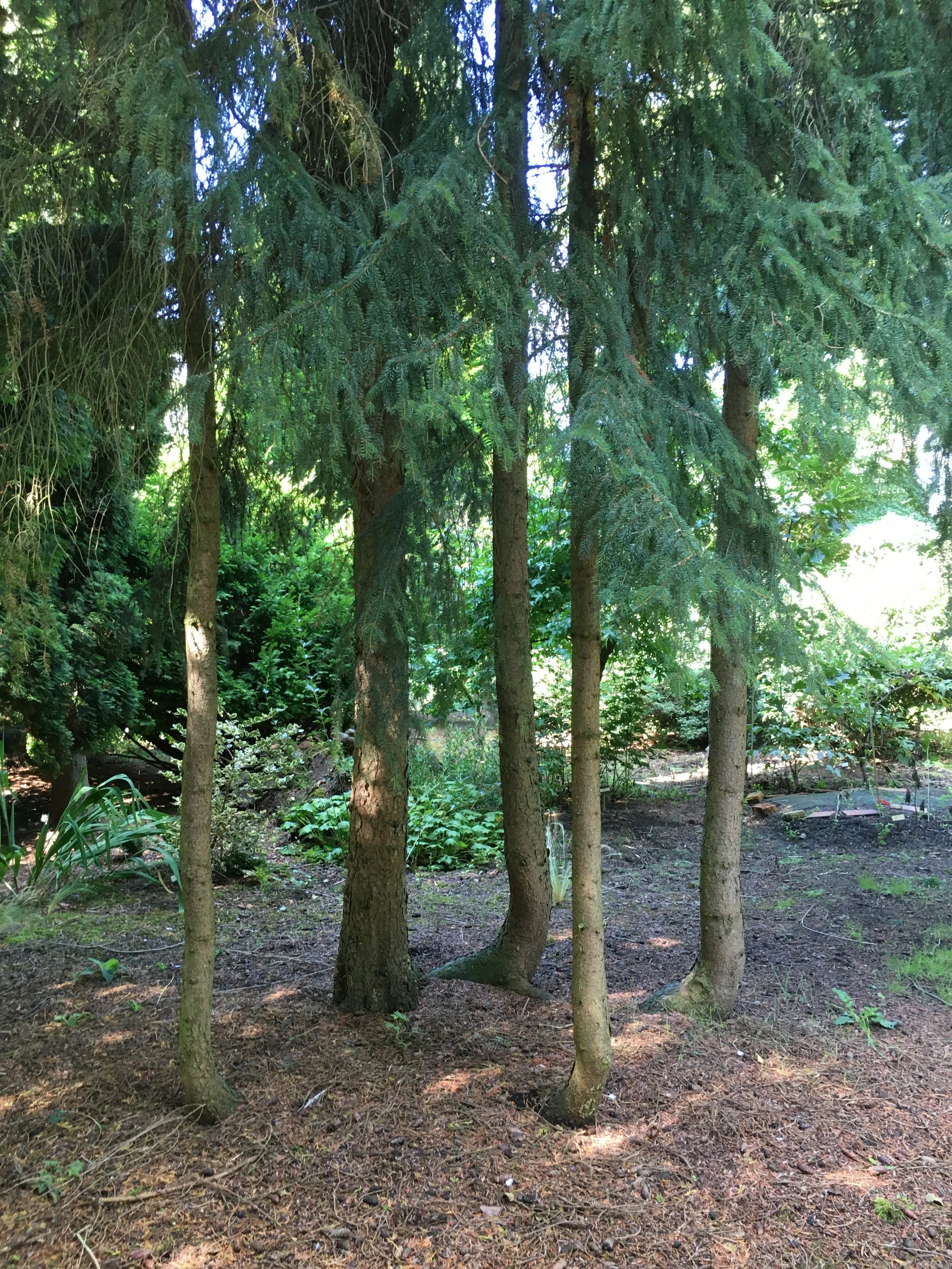
Incidentally the small village of Zaovine is in the Tara National Park in the Tara mountains, Serbia, close to a picturesque lake . The website guide to the National Park adds “ The Serbian Spruce is known among natural scientists throughout throughout the world because it grows only in the middle course of the Drina in Serbia and Bosnia. It is one of the oldest species in European flora. It originates from the Tertiary Period, the time in the Earth’s history that came after the extinction of the dinosaurs and lasted until the ice age.” The ice age then destroyed much of the flora of Europe , “ However, the Serbian Spruce found refuge in the canyon of the Drina where it hid until 1875 “ ! ( my exclamation mark following slight shortening of the information ). Perhaps the most authoritative research was done for the 8th edition of W.J.Bean’s encyclopedic Trees and Shrubs, and it is Bean’s Decription that has been used for the information found on the important new resource set up by the International Dendrology Society Trees and Shrubs Online (see Bibliography )
The Monumental Trees website suggests that because of the steep slopes and ravines the area where the narrowest trees grow ” is inaccessible”.
This is highlighted by Tom Christian , who is a botanist with The Royal Botanic Gardens at Edinburgh , and Assistant Editor of Trees and Shrubs Online (TSO), and who visited whilst researching the present , very limited habitat of Picea omorika. In his email he explained ;
Perhaps one other reason the species was not discovered until relatively late, besides the remote area, is the extreme difficulty that exists in accessing the remaining stands even when you are in the area. When I was doing fieldwork there in 2010 we faced, every morning, long strenuous climbs up extremely steep hills until we came to the spruces, and even then they could not be climbed by conventional means, we had to climb adjacent species e.g. Pinus nigra and then lasso a Serbian Spruce! The other method was to access the crowns via cliffs. The purpose of the fieldwork was to make a new IUCN assessment based on detailed population data. The results and our observations are published here: https://threatenedconifers.rbge.org.uk/conifers/picea-omorika
The Serbian Spruce is now an Endangered Species , something perhaps few of us would have been aware , and perhaps will make us treasure the plants we have and grow even more.
Picea omorika Pendula Bruns
The Bruns legacy ....but it is not as straightforward as you might think...
A fortuitous opportunity during the First World War led to the introduction of Picea omorika Pendula Bruns . Heinrich Bruns, then Head Gardener at the Bohlje nursery in Westerstede (and no relation to the present Bruns Nursery in Bad Zwiscenahn,) in the north German region of Ammerland was stationed as a soldier in Serbia at that time and had made contact with some of local people who later in the 1920’s sent him seeds of Picea omorika.
I have used various sources for some of the information used here , and more on those later in this article, but the following was quoted by noted German plantsman Gerd Krussmann, onetime Director of the Dortmund Botanic Gardens;
“ The plants in cultivation today (wrote Krussmann in 1972) no longer display the typical “ spire shape” . They are rather narrow , or widely conical as is more commonly found in the lower altitudes of the native range. The wide crowned type pre- dominates in the plains where the seed is more easily obtained, and therefore less expensive than that taken from the “ spire- shaped “plants of the high mountains.”
It maybe that the wider crowned type is represented by the selection called Picea omorika Bruns and most plants grown from seed.
I have been lucky enough to see conifers in the wild in many places in the world, but the upper reaches of the Tara mountains, observing the narrow spires and weeping forms of the Serbian Spruce is definitely on my bucket list! That said , Tom Christian’s story above might make this achievement difficult .
Heinrich Brun’s Discovery
In the mid 1920’s Heinrich had begun his own nursery, and amongst the seedlings he had received from Serbia were some narrow and distinctly weeping forms. One in particular was grafted and developed and was introduced and marketed in 1955 under the descriptive ,but rather dull name of Picea omorika Pendula Bruns. There had been a few selections made with the name ‘ Pendula’ which were also very narrow, spire- like and pendulous, but the novelty of ‘Pendula Bruns ‘ was the sharply falling branches which seemed to hug the trunk , whilst weeping branchlets densely clothed with dark green leaves and silver backed needles , often exposed, are an added attraction. As with most pendulous plants grafted plants often had to be trained up a cane until a leading shoot decided to continue a vertical direction.
Among the first US nursery to receive this new selection from Heinrich Bruns was F. W. Schumacher in Boston, Massachussetts, and it was then much sought after and distributed more widely. It would be interesting again to trace the distribution of this cultivar in the USA ..... Unfortunately that and the following are yet other stories to be told as the Heinrich Bruns nursery discontinued trading in the late 1960s . If for nothing else , Heinrich would at least be pleased that he and his nursery, are in the history books for his distinctive selection of Picea omorika.
From Heinrich to Johann Bruns
The story passes to another Bruns , no relation to Heinrich, but the company now called Bruns Planzen , situated in Bad Zwischenahn dates back to 1876 , and is now one of the largest nurseries in Europe and among most famous in the world. The present head of the Company is Jan-Dieter Bruns ,great grandson of founder Johann Bruns who adds information to what might , as you will see, help to muddy the waters ...
It was obvious that other nurseries would want to grow this new conifer species, almost discovered in their ‘ back yard ‘, and seed became increasingly available in the later 1920s. Johann Brun’s propagator was clever enough to purchase a large amount of seed from Serbian sources , knowing that if frozen in storage, some could be taken out as needed year by year , so if a shortage arose , the nursery could continue to grow seedlings and sell this increasingly popular plant.
Not unsurprisingly some of the seedlings raised by the nursery had narrow and weeping habits. The propagation manager at the time was Georg Hinrichs , who recognised the potential merits of a weeping form in 1965 and started to graft this plant . It seemed obvious that it should be called simply Picea omorika Pendula Bruns , an apt description of the habit of the plant. Somehow this got on to the market , and being very similar to Heinrich Bruns’ Picea omorika Pendula Bruns , confusion of identity was likely to occur. Perhaps there might have been confusion anyway , but the later selection needed a different , perhaps striking cultivar name , even ‘ Bruns Weeping ‘ would have done.
So finally we have to accept that both forms are in cultivation , but the information sheet from the Bruns Pflanzen Nursery ends with ;
“The Picea omorika Pendula forms selected by Heinrich Bruns as well as the Picea omorika Pendula forms selected by Johann Bruns are on the market as Picea omorika Pendula Bruns.
Which of these two types of Picea omorika Pendula Bruns achieved special importance in America is no longer detectable today.
However, it can be assumed that the Picea omorika Pendula Bruns known in America ( and no doubt else where in the world...my comment ) was mainly selected by Heinrich Bruns. “
What are we to learn from this history of Picea omorika Pendula Bruns ?
1. That somehow a new plant should be different from any other. And that hindsight is a wonderful thing ...
2. But following on from 1. How would a nursery in ,say , New Zealand, finding a plant there, be expected to know that someone in Europe or the USA had discovered around the same time , something similar or almost identical ? (There are ways, but no time to go into it here.)
3. You might think that the two relatively close ( in regional terms) Bruns Nurseries , might have known of each others plants....but these forms would have taken at least 10 years to test and compare...and since there must be a difference , why wouldn’t a nursery after an investment taking time and money, decide to put their plant on the market ? Both were desirable specimens and no doubt had a ready market.
4. Were the Joh. Bruns nursery ( Bruns Pflanzen) , aware of the existence of an earlier selection under the name of Picea omorika Pendula Bruns, they would surely have given their own selection a different cultivar name . But remember this was over 50 years ago and whilst Jan-Dieter Bruns might now agree, this is now history and there are more urgent things to deal with. It largely seems that the Heinrich selection is now the main one in cultivation.
5. We are where we are and should it matter ? Whichever form you might have or want to buy, both will make a great plants ideal even for a smaller garden. I doubt if there would be any interest , nor any point to do DNA testing that is now available to us.
6. All good detective stories need a solution but few will end up end up with sleepless nights for not having the answer to the question -- “Have I got the real Picea omorika Pendula Bruns ? “
Picea omorika Pendula Bruns as a garden plant.
For the attention that the now 25 year old specimen in The Bressingham Gardens attracts it is obvious that it makes a striking and unusual conifer. It has some similarities in look and stature to the Weeping Giant Redwood , Sequoiadendron giganteum Pendulum, which is also to be seen at Bressingham.
It seems to go against nature in our gardens for something to have such a narrowly pendulous habit and although plants can be trained as vertical specimens , beyond 3m / 10ft. they largely on their own , leaning and curving its way skywards. In the Dell Garden at Bressingham the specimen planted for Robert Bloom in 1996 is now around 30ft high , and on it’s own amongst lower growing perennials it rises high enough to look like a pre-historic Tyrannosaurus peeking over the gardens , and clearly visible from 100 metres away at both ends of the garden. As mentioned , now at 10m. high our specimen seems to defy nature , and although it must have a good root system to support its habit, I have some trepidation , that sometime in the future our strong westerly winter winds may topple it over.
On the other hand the similar aged plant of Pendula Bruns I planted in my own garden Foggy Bottom, peeked it’s head up for a few years , before deciding keeping upright was too much like hard work , so it formed a rather ungainly but dramatic , slightly pre-historic arch.
There are two younger plants in Foggy Bottom which can still be pruned or trained....and this is the point for gardeners wanting to grow P.o. Pendula Bruns....these are slow enough growing plants that the gardener can decide what you need your eventual specimen to do.
Reading my notes about the origins of P.o. Pendula Bruns will help an understanding that the Serbian Spruce in general is a pretty tough plant , and exists in nature quite harsh and inhospitable conditions,. The narrower habited plants are found at higher altitudes, where they are not so likely be overwhelmed by heavy snowfall , nor be blown over by strong winds. They are also able to withstand drier conditions , particularly in summer,than many spruce .
Named cultivars such as P.o.’ Pendula Bruns’, P.o.’ Nana’ , and P.o.’ Bruns’ will have been propagated by grafting , and the same is most likely to apply to the narrow pendulous forms listed under the name ‘ Pendula ‘ whilst the more conical and slightly variable species of Serbian Spruce mostly are raised from seed, the latter making good background trees for large gardens or landscapes. Look in most conifer books and very few cultivars are named , in fact we can have the impression that there aren’t very many. Think again . In the late Derek spicer/Aris Auder Encyclopedia of Conifers a total of 63 cultivars are listed , though the majority are not widely available yet.

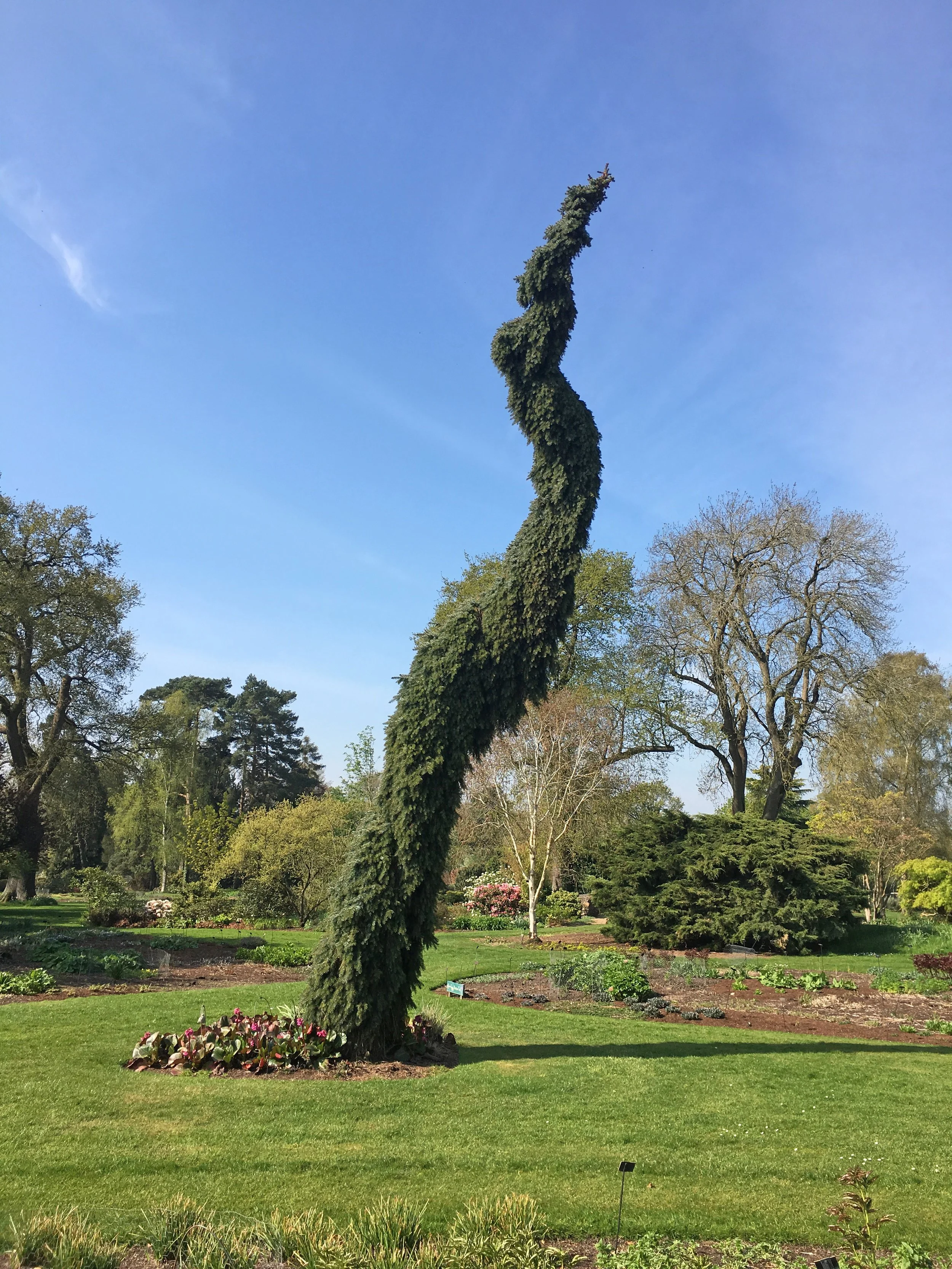

Another Serbian Spruce with a mysterious origin ?.....Picea omorika Bruns.
This plant which carries the Bruns name is not known or grown by the Bruns Nursery in Bad Zwischenahn in Germany, and it’s origin in Oregon , though relatively recent , is not entirely clear. Does it matter ? Not really , but since I was researching P.o. Pendula Bruns , it seemed this quite different plant might well have come from Bruns in Germany. I have seen it in the superb Iseli conifer garden surrounding their offices, and to my mind it represented a good form of the more pyramidal shaped plant widely used as a specimen representing the species, though it’s sharply upturned branches exposing the silvery undersides of the needles makes it a distinctive clonal selection, which is of course propagated by grafting.
I consulted with some old acquaintances and renowned plants people, and would like to thank Paul Halladin of Iseli Nurseries and Horst Jeddeloh, an american ‘cousin’ of the zu Jeddelohs from Jeddeloh 1. This is another famous nursery Germany close to Bad Zwischenahn who can trace their family back 800 years. Here’s how the story goes, and please follow very closely ;
It could be that Oregon nurseryman Larry Stanley ( who I haven’t contacted) may have been the first to have grown this plant , Picea omorika Bruns...perhaps more than 25 years ago. Paul Halladin saw the plant at the Stanley Nursery , and was able to source young grafted plants from Horst Jeddeloh for Iseli Nurseries to grow on in larger pots for their national nursery sales .
According to Horst Jeddeloh , it seems that both Larry Stanley and another legendary Oregonian nurseryman , Talon Buchholz had this plant before Horst started grafting it. So unless someone has a Eureka moment and remembers , the mystery of how this plant was given the Bruns name still remains unsolved.
As an addenda , Jan –Dieter Bruns , head of the famous Bruns Nursery in Germany is not aware and does not believe of any plants or grafts of this form of Picea omorika were ever sent by his nursery to the USA.


Adrian Bloom August 2020
Bibliography.
P.den Ouden and Dr. B. K. Boom . Manual of Cultivated Conifers 1965 Martinus Nihof, The Hague.
A. F. Mitchell Conifers in The British Isles 1972 HMSO Forestry Commission
W.J. Bean. Trees and Shrubs Hardy in The British Isles . 8th Edition Vol. 3 1976 John Murray
Dr. Gerd Krussmann Manual of Cultivated Conifers 1985 Timber Press
James E. Eckenwalder Conifers of the World 2009 Timber Press
Hillier Manual of Trees and Shrubs Eighth Edition 2014 RHS
Derek P. Spicer and Aris G. Auders Encyclopedia of Conifers Vol. 1 2012 RHS
Bruns Pflanzen Sortimentskataalog . p. 720 (of 1130 pages, a weighty volume ! )
Trees and Shrubs Online www.treesandshrubsonline.org / www.dendrology.org
Picture Credits. Thanks to Tom Christian for images taken in Serbia and Bosnia All remaining garden and plant pictures by Adrian Bloom.
